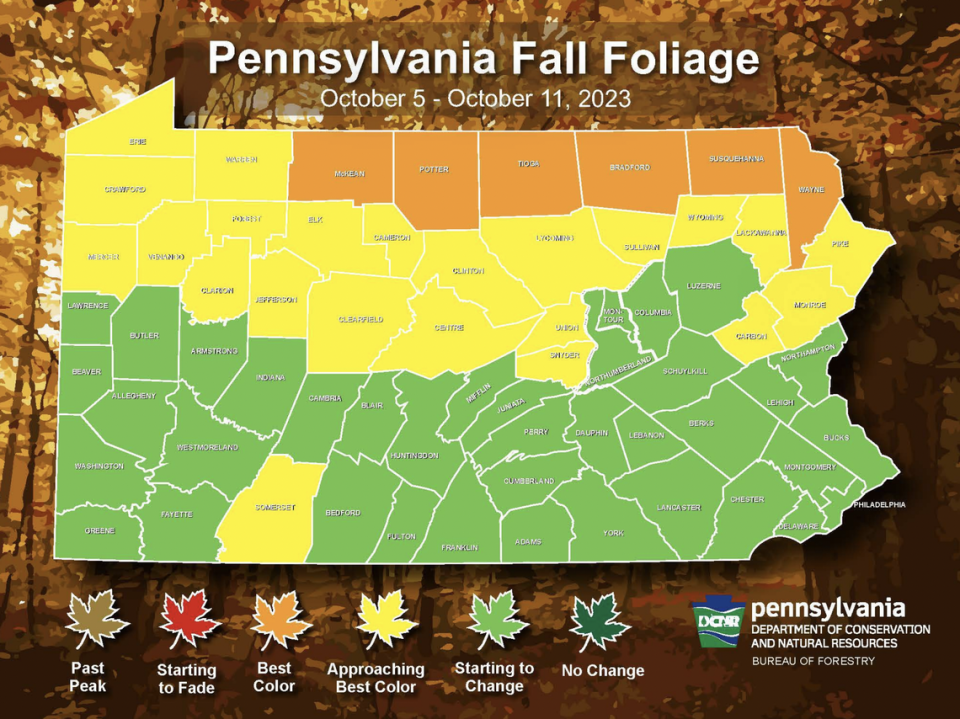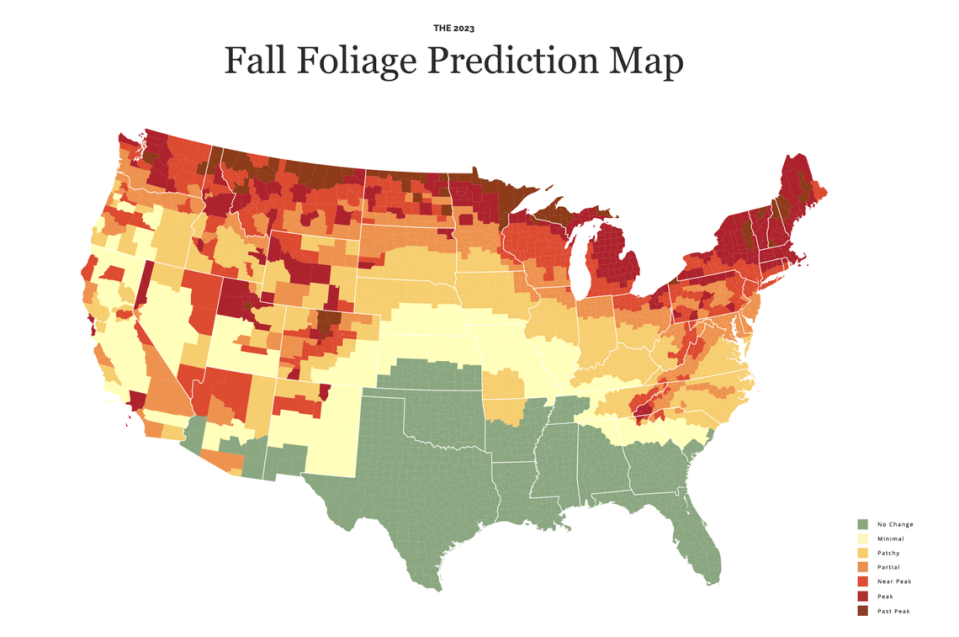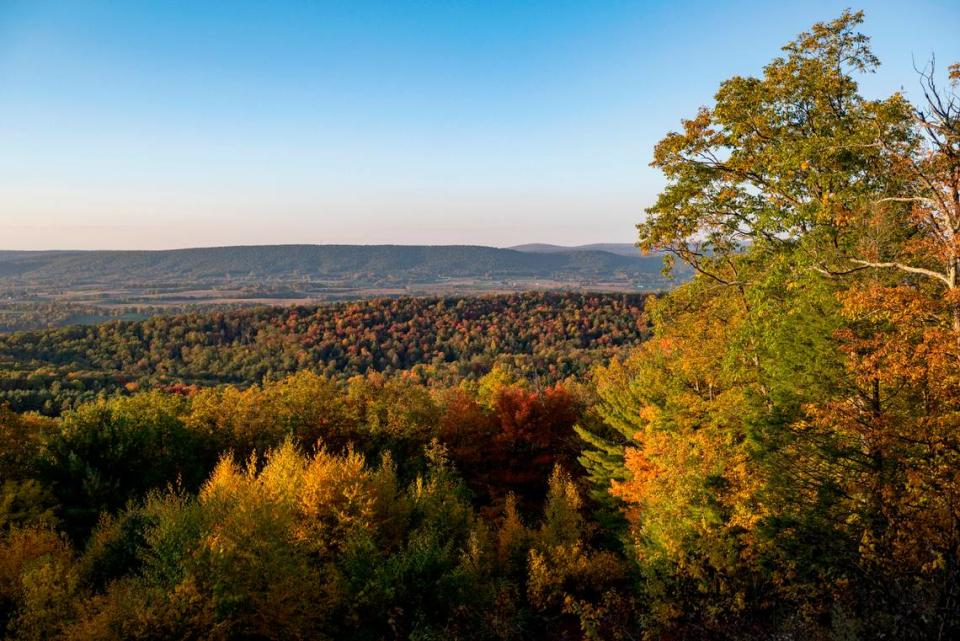Fall foliage is approaching peak color in central Pennsylvania. Here’s the 2023 outlook
Eastern North America is one of only three regions in the world whose forests offer beautiful colors each autumn, and they’re about to hit their peak in Centre County and much of Pennsylvania.
The Pennsylvania Department of Conservation and Natural Resources expects the best colors to arrive in Centre County in roughly one week, landing in mid-October. That estimate comes courtesy of the DCNR Bureau of Forestry’s weekly fall foliage report for the week of Oct. 5-11.
The agency says peak colors are already beginning to fade in some parts of northern Pennsylvania, including Potter, Wayne and Susquehanna counties. Large swaths of central and northwestern Pennsylvania, including Somerset County and the Scranton area, should see their best foliage colors peak within the next week or so.

The Smoky Mountains Fall Foliage Prediction Map, generated annually using data from the National Oceanic and Atmospheric Administration, offers color predictions for the continental U.S.
For now, the map claims most of Pennsylvania will approach peak color during the week of Oct. 9, with Centre County hitting its peak.

The Smoky Mountains Fall Foliage Prediction map offers an interactive, week-by-week look at the development of fall foliage throughout the country. You can explore it online by visiting smokymountains.com/fall-foliage-map.
The long-trusted Farmers’ Almanac claims peak foliage in Pennsylvania will stretch from about Oct. 5-21 this year.
Pennsylvania’s 2023 fall foliage outlook
Though an early lack of rainfall in the spring might have once put a damper on 2023’s fall foliage forecasts, a wetter summer and fall have generally turned things around. Pennsylvania experts like Ryan Reed, a natural resource program specialist with the DCNR’s Bureau of Forestry, predict a robust season of autumn color is in store over the next few weeks.
“I think it’s going to have a minimal impact on foliage this year as far as the drought. I think people make more of it than maybe what’s necessary,” Reed said in an interview with the Centre Daily Times. “If you would’ve asked me about that in May when we were in the midst of that really long spring drought, I might’ve been telling a different story. Fortunately, in June and July and much of the summer, we received some timely rainfall. We never went an extreme amount of time in the summer without at least a good storm that passed through... I feel like we had timely enough rainfall to nourish the trees well enough to provide that nice, lush canopy that will, of course, change colors here this fall.”
The National Weather Service reports the State College area has received about 31.91 inches of precipitation in 2023 as of Oct. 10 — just about 1.14 inches below expectations for an average year through the middle of October. A few counties in western and southern Pennsylvania are still experiencing abnormally dry conditions, according to the U.S. Drought Monitor, but most counties are in the clear through mid-October.
Reed said his agency has received some localized reports of concerns with forest health this year, but the commonwealth’s sheer size should help it produce a strong fall foliage season overall.
“We’ve had a few reports of defoliation from spongy moths in some of the forests throughout central Pennsylvania. I have received a report of a minor outbreak of anthracnose fungus up in the north-central, but it seems to be all localized and not really widespread,” Reed said. “That’s the beauty of Pennsylvania. Our forests are huge, and publicly available forests — we’re talking many millions of acres of publicly available forests. If you happen to be in a small valley or something like that where it’s not too spectacular, fortunately, it would be just a small drive or hike or bike ride until you find some nice color in the region.”

More than 120 deciduous species make up Pennsylvania’s roster of native trees. Their distribution across the commonwealth’s many mixed forests helps to stretch out Pennsylvania’s fall foliage season and produce a more impactful showing each autumn.
“What’s cool about that is that it tends to spread out the peak,” Reed said. “You’ll have this awesome early peak where it seems like there’s color everywhere with the northern hardwoods (like maple and cherry trees), and just as they’re starting to tail off, we’ll have the oaks and the hickory forests carry the torch. That’s really fun because it elongates the season and adds a lot of diversity to the color palette.”
Why do leaves change colors in the fall?
Changing hues throughout Pennsylvania’s forest canopies has a far greater purpose than just looking pleasant. In fact, the transition from lush greens to shades of red, orange and yellow represents one part of some tree species’ preparations for winter.
Chlorophyll, which gives leaves their green pigment in the spring and summer, helps produce food for trees through photosynthesis. Less sunlight in the fall ends chlorophyll production and signals winter is coming soon.
As you might expect, other natural compounds give leaves their autumnal hues. Xanthanophyll and beta-carotene are responsible for browns, oranges and yellows, while anthocyanin can bring about reds and purples.
Precipitation is a key factor for tree and leaf health, and a lack of summer and fall rainfall can speed up the transition away from summer greens. Declining amounts of sunlight throughout autumn can also affect leaf colors.
According to the DCNR, Pennsylvania has a longer and more varied fall foliage season than any other state in the U.S. and, perhaps, the rest of the globe. The commonwealth’s exact location helps a wide range of tree species thrive each year, the agency writes.
“Pennsylvania’s location between 40º and 42º North latitude and its varied topography from sea level on the coastal plain to over 3,000 feet in the Laurel Highlands supports 134 species of trees and many more shrubs and vines that contribute to the display of autumn color,” the DCNR wrote. “Pennsylvania is the meeting ground of northern trees that flourish only on mountain tops farther south and southern species that are at the northern limits of their range.”
Where are the best spots for fall foliage in Centre County?
Pennsylvania’s unique set of conditions and features make it a great pick for viewing fall foliage. Cooler temperatures in mid-October could speed up the transition as peak foliage arrives soon.
The commonwealth’s tourism bureau recently published a list of the 10 best spots to view this autumn’s colors, which include Rothrock State Forest in State College. The DCNR says optimal driving routes include Route 504, Benner Run Road and Tram Road in Centre County. Nearby state parks like Parker Dam and Black Moshannon are great options too.
“I’ve had the good fortune of spending a lot of time throughout Bald Eagle State Forest, which is smack-dab in the center of the state and kind of east and northeast of State College. I think that state forest probably offers one of the greatest opportunities for fall foliage viewing,” Reed said, noting the park offers opportunities for fishing, biking and kayaking. “It’s well known for holding easily accessible vistas that you can drive through on state forest roads, and to take in a vista when it is wall-to-wall color throughout the viewer area, it’s really breathtaking. Our Bald Eagle State Forest offers just an immense number of opportunities for that.”
Those in neighboring areas might choose to visit routes 153, 255, 55 and U.S. 322 in Clearfield County, the agency said in its fall foliage report. Tyler, Laurel Run and Laurel Ridge roads are great state forest roads in Clearfield County for fall foliage viewing, the DCNR wrote.
Each year’s fall foliage season brings countless Pennsylvanians into the commonwealth’s parks and forests. Reed says there’s no better time to appreciate the environment and leave outdoor environments intact.
“The fall season is kind of like the grand finale for our trees. It really is a moment when ordinary folks who may not be interested in conservation or natural resources will stop and observe the grandeur of our forests, and I encourage everyone to take that one step forward and consider all of the benefits our forests provide when it comes to clean air, clean water and wildlife habitat,” Reed said. “Our forests are there for everyone in Pennsylvania, and we encourage everyone to get out there and experience it. It truly is one of nature’s finest wonders, and we are very privileged and blessed in Pennsylvania to have this. We shouldn’t take it for granted.”
Service journalism editor Jackie Starkey contributed to this report.

